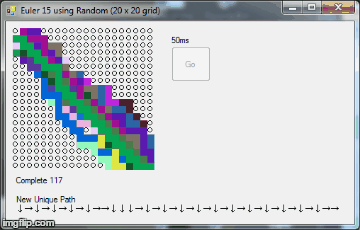Mapping paths..
public static Brush aBrush = (Brush)Brushes.Black; public static string path_collect = ""; public static LinkedList<string> complete_paths = new LinkedList<string>(); public bool wall = false; public bool floor = false; public static int miliseconds = 15; public int current_x = 10; public int current_y = 10; public Form1() { InitializeComponent(); } private void Form1_Load(object sender, EventArgs e) { label3.Text = miliseconds + "ms"; } private void Form1_Paint(object sender, PaintEventArgs e) { int x = 10; int y = 10; for (int i = 1; i < 21; i++) { for (int j = 1; j < 21; j++) { e.Graphics.DrawEllipse(Pens.Black, x* i , y *j, 6, 6); } } } private void bntPath_Click(object sender, EventArgs e) { bntPath.Enabled = false; backgroundWorker1.RunWorkerAsync(); } protected void Move(string path) { Graphics g = this.CreateGraphics(); foreach (char c in path) { if (c == '0') { g.FillRectangle(aBrush, current_x + 10, current_y, 10, 10); current_x += 10; path_collect += "→"; } else if (c == '1') { g.FillRectangle(aBrush, current_x, current_y + 10, 10, 10); current_y += 10; path_collect += "↓"; } } current_x = 10; current_y = 10; label2.Text = "New Unique Path\r\n" + path_collect; Brush NewBrush = new SolidBrush(GetRandomColor()); aBrush = NewBrush; path_collect = ""; } private void backgroundWorker1_DoWork_1(object sender, DoWorkEventArgs e) { /* while (true) { MoveRandom(); Thread.Sleep(miliseconds); } */ Int64 i = 0; Int64 count_unique_paths = 0; while (true) { string bits = Convert.ToString(i, 2).PadLeft(38, '0'); string check = bits; check = Regex.Replace(check, "0", ""); if (check.Length == 19) { Move(bits); //Thread.Sleep(50); count_unique_paths += 1; label4.Text = "Distinct Paths " + count_unique_paths; } i += 1; } } string row = ""; public bool completerow = true; private Random random; private Color GetRandomColor() { random = new Random(); return Color.FromArgb(random.Next(0, 255), random.Next(0, 255), random.Next(0, 255)); } protected void MoveRandom() { Graphics g = this.CreateGraphics(); Random rand = new Random(); int random = rand.Next(0, 2); if (random == 0) { if (!wall) { g.FillRectangle(aBrush, current_x + 10, current_y, 10, 10); current_x += 10; path_collect += "→"; } } else if (random == 1) { if (!floor) { g.FillRectangle(aBrush, current_x, current_y + 10, 10, 10); current_y += 10; path_collect += "↓"; } } CheckWall(); } protected void CheckWall() { if (current_x == 200) wall = true; if (current_y == 200) floor = true; if (wall && floor) { current_x = 10; current_y = 10; wall = false; floor = false; if (!complete_paths.Contains(path_collect)) { complete_paths.AddLast(path_collect); label1.Text = "Complete " + complete_paths.Count; label2.Text = "New Unique Path\r\n" + path_collect; } Brush NewBrush = new SolidBrush(GetRandomColor()); aBrush = NewBrush; path_collect = ""; } } |
//Some fun with random paths at different speeds.


Looks nice!